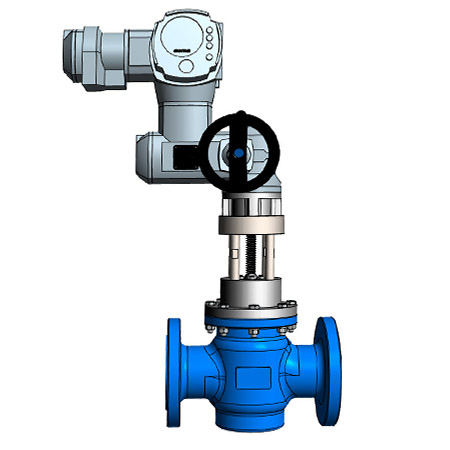Enhancing Functional Performance with Advanced Control Valves
Enhancing Functional Performance with Advanced Control Valves
Blog Article

Maximize Power Savings and Convenience With Advanced Structure Automation Controls
In the realm of modern design and center administration, the integration of innovative building automation regulates stands as an essential innovation. By taking advantage of the power of automation, structures can adapt, react, and advance in ways that were as soon as unthinkable.
Power Performance Benefits
Power performance advantages can dramatically reduce power intake and functional expenses in buildings. Energy-efficient systems, such as advanced building automation controls, can maximize the usage of resources like air conditioning, illumination, and heating, leading to reduced power costs over time.
Additionally, improved energy efficiency can prolong the lifespan of building equipment and systems. By operating a lot more efficiently, cooling and heating systems, lighting fixture, and various other building elements experience much less deterioration, resulting in minimized maintenance and substitute prices. Additionally, energy-efficient buildings frequently command greater property worths and rental prices, providing long-lasting monetary advantages to proprietors.
In addition, power effectiveness can enhance occupant comfort and performance. Properly managed interior environments with optimal lights and thermal problems create a more conducive and pleasant work space, leading to improved worker contentment and performance. Generally, the power efficiency advantages connected with innovative building automation controls are complex, including price savings, environmental stewardship, and owner well-being.
Improved Convenience Control
Enhancing comfort control in building environments calls for an innovative integration of innovative automation systems for ideal occupant wellness. By making use of advanced building automation controls, centers can customize the indoor environment to fulfill the details requirements and preferences of occupants. control valves.
By including these innovative controls, buildings can not only enhance comfort however also enhance energy performance by maximizing system operations based on actual occupancy and use patterns. Inevitably, focusing on resident convenience with sophisticated automation systems leads to a much more enjoyable and much healthier indoor setting.
Operational Efficiency Improvements

Furthermore, the execution of real-time tracking and analytics devices makes it possible for structure operators to identify energy ineffectiveness and operational abnormalities promptly. By constantly keeping track of power use patterns and system performance metrics, adjustments can be made in real-time to enhance power consumption and make sure peak operational efficiency. control valves. Furthermore, including need reaction methods right into building automation controls can even more improve functional performance by dynamically adjusting power usage based on grid conditions and prices signals
Indoor Environment Optimization
Reliable interior climate optimization is an essential element of structure automation controls, guaranteeing passengers' convenience and well-being while taking full advantage of power savings. By utilizing advanced sensors and controls, developing automation systems can continually change and check temperature, humidity levels, air top quality, and air flow to develop an optimum interior atmosphere. Preserving comfortable and consistent problems not just boosts owner satisfaction but also boosts performance and total health.
Interior climate optimization also plays an important role in energy efficiency. By fine-tuning air flow, air conditioning, and heating systems based on real-time data and tenancy patterns, developing automation controls can substantially minimize power intake - control valves. Carrying out approaches such as demand-controlled air flow and thermal zoning can assist minimize power waste while making certain that each area of the building receives the needed conditioning.

Lasting Environment Development
Building automation controls not only optimize interior environment conditions for energy efficiency and occupant comfort but also lay the structure for developing a lasting atmosphere with calculated monitoring of resources and systems. By integrating advanced structure automation technologies, such as sensing units, actuators, and smart software application, centers image source can change and monitor energy use in real-time to decrease waste and lower their carbon impact. These systems allow anticipating maintenance, determining possible problems prior to they rise and enhancing devices efficiency to improve long life and effectiveness.
Furthermore, lasting environment production expands past energy administration to include water conservation, waste decrease, and interior air top quality enhancement. Building automation controls can regulate water use, detect leakages, and make sure correct waste see it here disposal techniques, adding to total sustainability initiatives. Additionally, by keeping track of and controlling air flow and filtering systems, these innovations improve occupant wellness and efficiency while lowering energy consumption connected with HVAC procedures.
Final Thought
Finally, advanced structure automation regulates deal significant benefits in regards to energy cost savings, comfort control, functional performance, indoor climate optimization, and creating a sustainable atmosphere. By implementing these controls, buildings can accomplish ideal efficiency while lowering energy consumption and enhancing resident convenience. It appears that the use of advanced automation innovation is critical in enhancing building performance and developing a more sustainable future.
Energy effectiveness advantages can significantly decrease power intake and operational expenses in structures. In general, the power efficiency advantages connected with sophisticated building automation controls are Related Site complex, including expense financial savings, ecological stewardship, and resident health.
In addition, integrating need reaction strategies right into building automation controls can better improve operational effectiveness by dynamically changing power use based on grid conditions and pricing signals.
Building automation controls not only optimize interior climate conditions for power effectiveness and resident comfort yet additionally lay the structure for producing a sustainable setting via tactical administration of sources and systems.In conclusion, progressed structure automation regulates deal considerable advantages in terms of power cost savings, convenience control, functional efficiency, indoor climate optimization, and developing a sustainable atmosphere.
Report this page